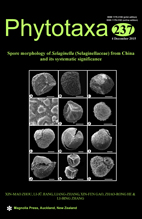Abstract
Using light microscope (LM) and scanning electron microscope (SEM), the megaspores and microspores of 77 samples representing ca. 70 species of Selaginella from China are observed. Combing previous studies, the spore morphology of nearly all documented Selaginella species from China were reviewed. Based on the morphological characteristics in megaspores and/or microspores, we divided the spores of Chinese species into 15 types and three types are further divided into various subtypes. Each type and subtype are described in detail and a key to the types and subtypes of spores is given. For the first time, the systematic significance of microspores of Selaginella are discussed, and the results indicate that microspores of Selaginella are significant in the systematics of Selaginella. Some important morphological characteristics in spores (e.g., color, micro-sculpture, size, etc.), often been neglected in previous studies, are introduced. Some spore-morphological synapomorphies of the clades and subclades, identified by recent molecular work (Zhou et al. 2015a), are well established. Using the spore morphology, the delimitation of some taxonomically difficult species in Selaginella is assessed.

